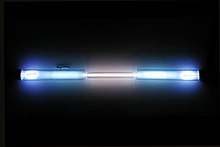Frae Wikipedia, the free beuk o knawledge
Krypton, 36 Krypton Pronunciation (KRIP -ton Appearance colourless gas, exhibitin a whitish glow in a heich electric field Standard atomic weight A r, std (Kr) 7001837980000000000♠ 83.798(2)[ 1] Krypton in the periodic cairt
Atomic nummer (Z ) 36 Group group 18 (noble gases) Period period 4 Block p-block Element category Noble gas Electron confeeguration [Ar ] 3d10 4s2 4p6 Electrons per shell 2, 8, 18, 8 Pheesical properties Phase at STP gas Meltin pynt 115.78 K (-157.37 °C, -251.27 °F) Bylin pynt 119.93 K (-153.415 °C, -244.147 °F) Density (at STP) 3.749 g/L whan liquid (at b.p. ) 2.413[ 2] 3 Treeple pynt 115.775 K, 73.53[ 3] [ 4] Creetical pynt 209.48 K, 5.525[ 3] Heat o fusion 1.64 kJ/mol Heat o vapourisation 9.08 kJ/mol Molar heat capacity 5R /2 = 20.786 J/(mol·K) Vapour pressur
P (Pa)
1
10
100
1 k
10 k
100 k
at T (K)
59
65
74
84
99
120
Atomic properties Oxidation states 0 , +1, +2 (rarely mair nor 0; oxide is unknown)Electronegativity Pauling scale: 3.00 Covalent radius 116±4 pm Van der Waals radius 202 pm Colour lines in a spectral range Spectral lines o kryptonIther properties Naitural occurrence primordial Creestal structur face-centred cubic (fcc) Speed o soond (gas, 23 °C) 220, (liquid) 1120 m/s Thermal conductivity 9.43×10-3 W/(m·K) Magnetic orderin diamagnetic [ 5] CAS Nummer 7439-90-9 History Diskivery William Ramsay an Morris Travers (1898) First isolation William Ramsay an Morris Travers (1898) Main isotopes o krypton
Decay modes in parentheses are predictit, but hae nae yet been observed | references
style="text-align:left"|
in
calc from C
diff
report
ref
C
—
—
K
115.78
115.78
0
F
-251.27
−251.27
0
WD
String Module Error: Target string is empty !
input
C: -157.37, K: 115.78, F: -251.27
comment
style="text-align:left"|
in
calc from C
diff
report
ref
C
—
—
K
119.93
119.735
0.195
delta
F
-244.147
−244.147
0
WD
String Module Error: Target string is empty !
input
C: -153.415, K: 119.93, F: -244.147
comment
References
Thir references will appear in the airticle, but this list appears anerly on this page.
↑ Meija, Juris; et al. (2016). "Atomic weights of the elements 2013 (IUPAC Technical Report)" . Pure and Applied Chemistry 88 (3): 265–91. doi :10.1515/pac-2015-0305 ↑ Krypton . encyclopedia.airliquide.com↑ a b Haynes, William M., ed. (2011). CRC Handbook of Chemistry and Physics CRC Press . p. 4.121. ISBN 1439855110 ↑ "Section 4, Properties of the Elements and Inorganic Compounds; Melting, boiling, triple, and critical temperatures of the elements". CRC Handbook of Chemistry and Physics (85th ed.). Boca Raton, Florida: CRC Press. 2005. ↑ Magnetic susceptibility of the elements and inorganic compounds , in Lide, D. R., ed. (2005). CRC Handbook of Chemistry and Physics (86th ed.). Boca Raton (FL): CRC Press. ISBN 0-8493-0486-5



